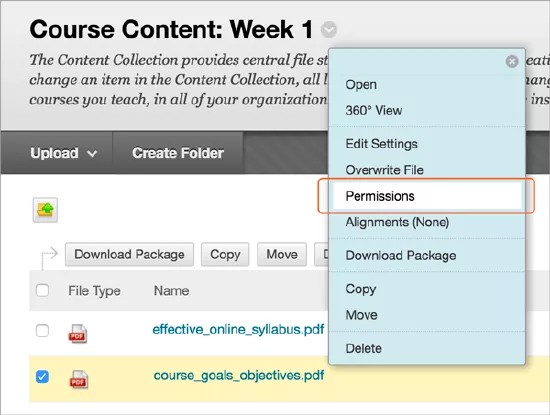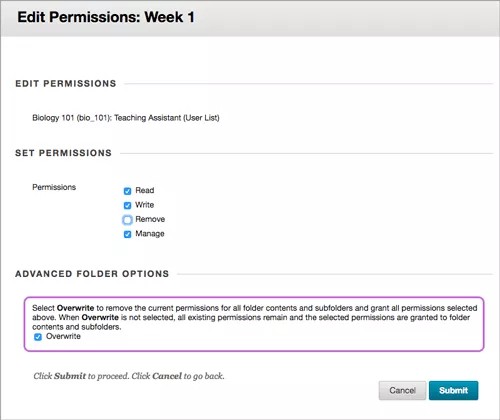You can control user access to an item through the Manage Permissions page. You can grant permissions to individual users separately, or you can assign permissions to groups of users, such as all the users enrolled in a particular course or all the users with a certain Institution Role. These groupings are based on user information in Blackboard Learn.
You can edit permissions for both files and folders.
When you edit permissions for a folder, the permissions apply to all sub-folders and files within the folder. For example, if you grant a user read permission for a folder, the user will also have read permission for all sub-folders and files within the folder. You can remove read permission from specific sub-folders and files. You and your classmates can work in the same folder and you can hide certain items from other users.
After you edit folder permissions, check to make sure that private sub-folders and files have the appropriate permissions.
Find the Manage Permissions page
- In the Content Collection, navigate to the folder that contains the item.
- Select Permissions from the item's menu.
- Choose an option to get started.
- Select Specific Users: Select this option to set permissions for one user or multiple users. If you want to add more than one username in the Select Users section, separate each username with a comma.
- Select Specific Users by Place: Select this option to set permissions based on a list of users in a course, a course group, an organization, or organization group. For Course or Organization, you can refine the list of users based on their role. For example, you can grant Manage permission for all Teaching Assistants in your biology course. To do this, choose Select Specific Users by Place > Course, select the course and roles within that course, and then choose the permissions you'd like them to have.
- Select Roles: To grant permissions to all users in the system, choose All Roles in this list. Choose Institution Roles to assign permissions based on system roles for your institution, such as Instructor or Teaching Assistant. This option lets you choose system roles to view your content, whether or not they are enrolled in your course.
- Permit Anyone: Select this option to add public permissions to a folder. This option allows users with or without system accounts to access the folder according to the permissions you choose.
- Select the users or groups for the permission settings, and then choose their permissions.
- Select Submit to save.
Delete or edit permissions
To delete permissions for a user or group, go to the Manage Permissions page, select the check box next to User/User List and select Delete. All of the selected users and lists will have their permissions removed. After permissions are removed, the users can no longer access the item.
To edit permissions for a user or group, open the item's menu and select Edit. Revise the permissions as desired and select Submit.
Option to overwrite folder permissions
When you edit or add permissions to a parent folder, you have the Overwrite option, which forces all files and sub-folders to inherit these permissions. For example, if the read and write permissions are added to the folder and you select Overwrite, all permissions to items within that folder are reset to read and write. Any item within the folder that has other permissions, such as remove, are reverted back to only read and write permissions.
If you don't select the Overwrite option, the files and sub-folders are automatically granted any additional permission given to the parent folder, but existing permissions aren't deleted. For example, if read, write, and manage permissions are added to the folder, and an item within the folder already has read, write, and remove permissions, the permissions for the file remain read, write, and remove, and manage is added.
After you edit permissions on a folder, you may edit the permissions on an item, but these permissions are overwritten the next time permissions on the parent folder are edited. We recommend you store items with the same purpose and audience in a single folder. Then, you can manage permissions easily.
How course changes affect permissions
If your courses and groups change, the permissions you've set up may be affected.
- If a group is deleted from a course, the group no longer appears on this page and the permissions are removed.
- If a course is made unavailable, the groups related to this course still appear on this page and permissions remain.
- If a course is disabled, the groups no longer appear on this page and permissions are removed.
Permissions warning
Editing permissions may impact users who access an item through a course or portfolio. For example, if a user doesn't have read permission for an item, but a link to the item is in a portfolio, the link will be broken for that user. If the user is granted read permission, the link will work.
When a user edits the permissions on an item that's shared with a portfolio or course, a warning appears that this action will break existing links to the item. The user can cancel the action or choose to continue.


